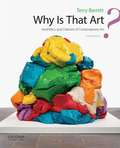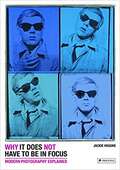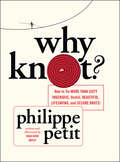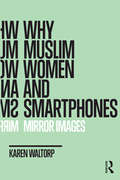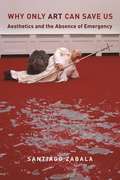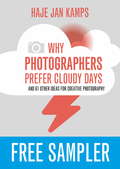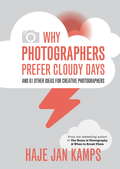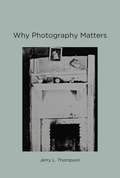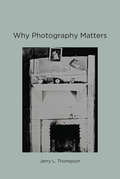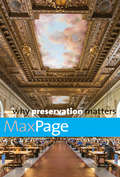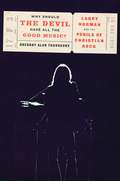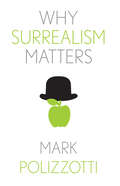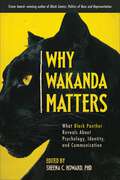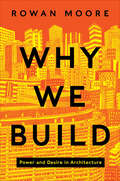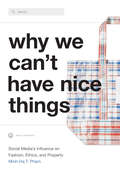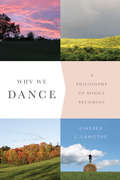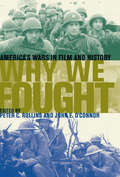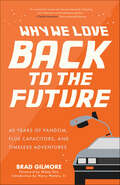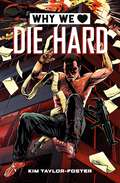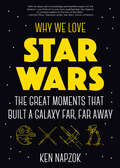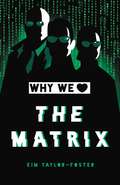- Table View
- List View
Why Is That Art: Aesthetics and Criticism of Contemporary Art
by Terry BarrettIt introduces students to theories of art through the presentation of contemporary works that include abstract and representational painting, animated film, monumental sculpture,performance art, photographs, relational art, and video installations.
Why It Does Not Have To Be In Focus: Modern Photography Explained
by Jackie HigginsThis lively, informed defense of modern photography focuses on not focusing--and other unconventional methods that have been successfully employed by acclaimed photographers. <p><p> In an age where anyone with a camera can call him- or herself a photographer, an apparent lack of technique might be mistaken for a lack of artistic sophistication. In this delightful follow-up to Why Your Five-Year-Old Could Not Have Done That, Jackie Higgins offers superb examples to counter that assumption, such as Hiroshi Sugimoto's anachronistic use of a 19th-century large-format camera to produce intentionally fuzzy pictures, and Richard Prince's controversial technique of "re-photographing" photos, which unleashed a barrage of criticism that he was profiting from others' work. <p><p> From portraits to documentary images and from abstractions to landscapes, the author identifies 100 important images that are emblematic of innovation in modern photography, revealing the frequently complex processes involved in their composition. In so doing, she offers a provocative reminder of what makes a great photograph.
Why Knot?: How To Tie More Than Sixty Ingenious, Useful, Beautiful, Lifesaving, And Secure Knots!
by Philippe Petit“Mr. Petit is the perfect teacher” in this fascinating, educational volume on knot-tying—an art and science that has held civilization together (The Wall Street Journal). Philippe Petit is known for his astounding feat of daring when, on August 7, 1974, he stepped out on a wire illegally rigged between the World Trade Center’s twin towers in New York City. But beyond his balance, courage, and showmanship, there was one thing Petit had to be absolutely certain of—his knots. Without the confidence that his knots would hold, he never would have left the ground. In fact, while most of us don’t think about them beyond tying our shoelaces, the humble knot is crucial in countless contexts, from sailing to sports to industrial safety to art, agriculture, and more. In this truly unique book, Petit offers a guide to tying over sixty of his essential knots, with practical sketches illustrating his methods and clear tying instructions. Filled with photos in which special knots were used during spectacular high-wire walks, quirky knot trivia, personal anecdotes, helpful tips, magic tricks, and special tying challenges, Why Knot? will entertain and educate readers of all ages. “In reading Philippe’s book we are cogently reminded that without the ability to secure a rope, or tether a goat, or make fast the sheets of a galley, much of the civilization that we take for granted would disappear as easily as a slipknot in the hands of a Vegas conjuror.” —Sting, musician and activist “His descriptions are clear, he deploys humor frequently and he makes his points with anecdotes that are colorful and memorable. Explaining the purpose and creation of knots and thanks to those flawless drawings Mr. Petit earns perfect marks.” —The Wall Street Journal
Why Living Things Need… Homes (Into Reading Texas, Read Aloud Module 9 #1)
by Daniel NunnNIMAC-sourced textbook
Why Muslim Women and Smartphones: Mirror Images (Criminal Practice Ser.)
by Karen WaltorpUsing an assemblage approach to study how Muslim women in Norrebro, Denmark use their phones, Karen Waltorp examines how social media complicates the divide between public and private in relation to a group of people who find this distinction of utmost significance. Building on years of ethnographic fieldwork, Waltorp's ethnography reflects the trust and creativity of her relationships with these women which in turn open up nuanced discussions about both the subject at hand and best practice in conducting anthropological research. Combining rich ethnography with theoretical contextualization, Waltorp's book alternates between ethnography and analysis to illuminate a thoroughly modern community, and reveals the capacity of image-making technology to function as an infrastructure for seeing, thinking and engaging in fieldwork as an anthropologists. Waltorp identifies a series of important issues around anthropological approaches to new media, contributing to new debates around the anthropology of automation, data and self-tracking.
Why Only Art Can Save Us: Aesthetics and the Absence of Emergency
by Santiago ZabalaThe state of emergency, according to thinkers such as Carl Schmidt, Walter Benjamin, and Giorgio Agamben, is at the heart of any theory of politics. But today the problem is not the crises that we do confront, which are often used by governments to legitimize themselves, but the ones that political realism stops us from recognizing as emergencies, from widespread surveillance to climate change to the systemic shocks of neoliberalism. We need a way of disrupting the existing order that can energize radical democratic action rather than reinforcing the status quo. In this provocative book, Santiago Zabala declares that in an age where the greatest emergency is the absence of emergency, only contemporary art’s capacity to alter reality can save us.Why Only Art Can Save Us advances a new aesthetics centered on the nature of the emergency that characterizes the twenty-first century. Zabala draws on Martin Heidegger’s distinction between works of art that rescue us from emergency and those that are rescuers into emergency. The former are a means of cultural politics, conservers of the status quo that conceal emergencies; the latter are disruptive events that thrust us into emergencies. Building on Arthur Danto, Jacques Rancière, and Gianni Vattimo, who made aesthetics more responsive to contemporary art, Zabala argues that works of art are not simply a means of elevating consumerism or contemplating beauty but are points of departure to change the world. Radical artists create works that disclose and demand active intervention in ongoing crises. Interpreting works of art that aim to propel us into absent emergencies, Zabala shows how art’s ability to create new realities is fundamental to the politics of radical democracy in the state of emergency that is the present.
Why Photographers Prefer Cloudy Days: Surprising And Inspiring Tips For Photographers
by Haje Jan Kamps**FREE SAMPLER** There's no one secret to taking beautiful photos, but good photographers build up a series of useful bits of know-how. They know that clouds, far from ruining a photo, give a great soft natural light for portraits. They know that unusual angles draw the eye, and that their feet are just as effective as a zoom lens.This book packs 62 of the most important creative ideas into one easy-to-read location, beautifully presented with example photos. None of these ideas need an expensive camera, fancy lens or a over-priced flash. The purpose of this book is to help you tell stories with your camera, whatever the camera.Whether you're photographing that perfect sunset or your morning coffee, Why Photographers Prefer Cloudy Days will show you how to capture it to best effect, whether you want it to look great on your Instagram, or amazing on your wall.
Why Photographers Prefer Cloudy Days: Surprising And Inspiring Tips For Photographers
by Haje Jan KampsThere's no one secret to taking beautiful photos. But good photographers do have a few tricks up theirsleeves... They know that clouds, far from ruining a photo, give a great soft natural light for portraits. They know that unusual angles draw the eye, and that their feet are just as effective as a zoom lens.This book packs 62 of the most important creative ideas into one place. Beautifully presented, easy-to-read and packed with example photos. None of these ideas need an expensive camera, fancy lens or a over-priced flash. The purpose of this book is to help you tell stories with your camera (or phone).Whatever you want to shoot, Why Photographers Prefer Cloudy Days is packed full of ideas to inspire you, and tips that will help you take better, more original photos.
Why Photographers Prefer Cloudy Days: and 61 Other Ideas for Creative Photography
by Haje Jan KampsThere's no one secret to taking beautiful photos. But good photographers do have a few tricks up theirsleeves... They know that clouds, far from ruining a photo, give a great soft natural light for portraits. They know that unusual angles draw the eye, and that their feet are just as effective as a zoom lens.This book packs 62 of the most important creative ideas into one place. Beautifully presented, easy-to-read and packed with example photos. None of these ideas need an expensive camera, fancy lens or a over-priced flash. The purpose of this book is to help you tell stories with your camera (or phone).Whatever you want to shoot, Why Photographers Prefer Cloudy Days is packed full of ideas to inspire you, and tips that will help you take better, more original photos.
Why Photography Matters
by Jerry L. ThompsonPhotography matters, writes Jerry Thompson, because of how it works -- not only as an artistic medium but also as a way of knowing. It matters because how we understand what photography is and how it works tell us something about how we understand anything. With these provocative observations, Thompson begins a wide-ranging and lucid meditation on why photography is unique among the picture-making arts. Thompson, a working photographer for forty years, constructs an argument that moves with natural logic from Thomas Pynchon (and why we read him for his vision and not his command of miscellaneous facts) to Jonathan Swift to Plato to Emily Dickinson (who wrote "Tell all the Truth but tell it slant") to detailed readings of photographs by Eugene Atget, Garry Winogrand, Marcia Due, Walker Evans, and Robert Frank. He questions Susan Sontags assertion in "On Photography" that "nobody" can any longer imagine literate, authoritative, or transcendent photographs. He considers the money-fueled expansion of the market for photography, and he compares ambitious "meant-for-the-wall" photographs with smaller, quieter works. Forcefully and persuasively, Thompson argues for photography as a medium concerned with understanding the world we live in -- a medium whose business is not constructing fantasies pleasing to the eye or imagination but describing the world in the toughest and deepest way.
Why Photography Matters
by Jerry L. ThompsonA lucid and wide-ranging meditation on why photography is unique among the picture-making arts.Photography matters, writes Jerry Thompson, because of how it works—not only as an artistic medium but also as a way of knowing. With this provocative observation, Thompson begins a wide-ranging and lucid meditation on why photography is unique among the picture-making arts. He constructs an argument that moves with natural logic from Thomas Pynchon (and why we read him for his vision and not his command of miscellaneous facts) to Jonathan Swift to Plato to Emily Dickinson (who wrote “Tell all the Truth but tell it slant”) to detailed readings of photographs by Eugène Atget, Garry Winogrand, Marcia Due, Walker Evans, and Robert Frank. Forcefully and persuasively, he argues for photography as a medium whose business is not constructing fantasies pleasing to the eye or imagination, but describing the world in the toughest and deepest way.
Why Preservation Matters
by Max PageCommemorating the fiftieth anniversary of the National Historic Preservation Act, a critique of the preservation movement--and a bold vision for its future Every day, millions of people enter old buildings, pass monuments, and gaze at landscapes unaware that these acts are possible only thanks to the preservation movement. As we approach the October 2016 anniversary of the United States National Historic Preservation Act, historian Max Page offers a thoughtful assessment of the movement's past and charts a path toward a more progressive future. Page argues that if preservation is to play a central role in building more-just communities, it must transform itself to stand against gentrification, work more closely with the environmental sustainability movement, and challenge societies to confront their pasts. Touching on the history of the preservation movement in the United States and ranging the world, Page searches for inspiration on how to rejuvenate historic preservation for the next fifty years. This illuminating work will be widely read by urban planners, historians, and anyone with a stake in the past.
Why Should the Devil Have All the Good Music?: Larry Norman and the Perils of Christian Rock
by Gregory ThornburyThe riveting, untold story of the “Father of Christian Rock” and the conflicts that launched a billion-dollar industry at the dawn of America’s culture wars. In 1969, in Capitol Records' Hollywood studio, a blonde-haired troubadour named Larry Norman laid track for an album that would launch a new genre of music and one of the strangest, most interesting careers in modern rock. Having spent the bulk of the 1960s playing on bills with acts like the Who, Janis Joplin, and the Doors, Norman decided that he wanted to sing about the most countercultural subject of all: Jesus. Billboard called Norman “the most important songwriter since Paul Simon,” and his music would go on to inspire members of bands as diverse as U2, The Pixies, Guns ‘N Roses, and more. To a young generation of Christians who wanted a way to be different in the American cultural scene, Larry was a godsend—spinning songs about one’s eternal soul as deftly as he did ones critiquing consumerism, middle-class values, and the Vietnam War. To the religious establishment, however, he was a thorn in the side; and to secular music fans, he was an enigma, constantly offering up Jesus to problems they didn’t think were problems. Paul McCartney himself once told Larry, “You could be famous if you’d just drop the God stuff,” a statement that would foreshadow Norman’s ultimate demise. In Why Should the Devil Have all the Good Music?, Gregory Alan Thornbury draws on unparalleled access to Norman’s personal papers and archives to narrate the conflicts that defined the singer’s life, as he crisscrossed the developing fault lines between Evangelicals and mainstream American culture—friction that continues to this day. What emerges is a twisting, engrossing story about ambition, art, friendship, betrayal, and the turns one’s life can take when you believe God is on your side.
Why Surrealism Matters (Why X Matters Series)
by Mark PolizzottiAn elegant consideration of the Surrealist movement as a global phenomenon and why it continues to resonate Why does Surrealism continue to fascinate us a century after André Breton’s Manifesto of Surrealism? How do we encounter Surrealism today? Mark Polizzotti vibrantly reframes the Surrealist movement in contemporary terms and offers insight into why it continues to inspire makers and consumers of art, literature, and culture. Polizzotti shows how many forms of popular media can thank Surrealism for their existence, including Monty Python, Theatre of the Absurd, and trends in fashion, film, and literature. While discussing the movement’s iconic figures—including André Breton, Leonora Carrington, Salvador Dalí, René Magritte, Man Ray, and Dorothea Tanning—he also broadens the traditionally French and male-focused narrative, constructing a more diverse and global representation. And he addresses how the Surrealists grappled with ideas that mirror current concerns, including racial and economic injustice, sexual politics, issues of identity, labor unrest, and political activism. Why Surrealism Matters provides a concise, engaging exploration of how, a century later, the “Surrealist revolution” remains as dynamic as ever.
Why Theatre Matters
by Kathleen GallagherWhat makes young people care about themselves, others, their communities, and their futures? In Why Theatre Matters, Kathleen Gallagher uses the drama classroom as a window into the daily challenges of marginalized youth in Toronto, Boston, Taipei, and Lucknow. An ethnographic study which mixes quantitative and qualitative methodology in an international multi-site project, Why Theatre Matters ties together the issues of urban and arts education through the lens of student engagement. Gallagher's research presents a framework for understanding student involvement at school in the context of students' families and communities, as well as changing social, political, and economic realities around the world.Taking the reader into the classroom through the voices of the students themselves, Gallagher illustrates how creative expression through theatre can act as a rehearsal space for real, material struggles and for democratic participation. Why Theatre Matters is an invigorating challenge to the myths that surround urban youth and an impressive study of theatre's transformative potential.
Why Unicorn Drinks
by C. W. MossUnicorns are just like us. They have problems, stresses, and like to blow off some steam. Author and illustrator C. W. Moss explores the inner psyche of the single-horned in Why Unicorn Drinks.A follow-up to Unicorn Being a Jerk, this volume of 67 four-color illustrations and captions gives readers a glimpse into the sad reality of life as a mythical creature, and reveals what drives Unicorn to the bottle.As fans of Moss' online comic undoubtedly know, Why Unicorn Drinks pours a double-shot of laughter and irreverence. You'll never look at a unicorn the same way again.
Why Wakanda Matters: What Black Panther Reveals About Psychology, Identity, and Communication
by Sheena C. HowardIn 2018, the Marvel Cinematic Universe finally delivered on something fans had long been waiting for: a feature film with a solo Black superhero. Black Panther introduced viewers to the stunning world of Wakanda, a fictional African country with incredible technological advancements, and to T'Challa, a young man stepping into his role as king and taking up the mantle of the Black Panther title from his late father. The unforgettable story, coupled with the film's mega-success, has undoubtedly shaped the future of superhero cinema, in addition to genuinely changing viewers' lives. Why Wakanda Matters gives this iconic film the in-depth analysis it deserves under the lens of the latest psychological concepts-as well as delving into the lasting cultural impact of this unforgettable story. Edited by Sheena C. Howard, an award-winning author, filmmaker, and scholar, Why Wakanda Matters: What Black Panther Reveals About Psychology, Identity, and Communication features a collection of essays from leading experts in a variety of fields who offer insightful perspectives on topics such as: Cognitive dissonance: The important messages within T'Challa's nuanced identity and eventual shift from nationalism to globalism. Intergenerational trauma and resistance: How N'Jadaka (aka Erik/Killmonger) identifies with the trauma that his ancestors have suffered. Social identity: How Nakia, Shuri, Okoye, and Ramonda—all empowered, intelligent, and assertive women of color—can make a lasting impression on women and girls. Collective identity: How Black Panther has created a shared fantasy for Black audience members—and why this is groundbreaking. Cultural and racial identity: What we can learn from Black Panther's portrayal of a culture virtually untouched by white supremacy. Fans of the movie and those interested in deeper discussions about the film will revel in this thought-provoking examination of all aspects of Black Panther and the power of psychology.
Why We Build: Power and Desire in Architecture
by Rowan MooreIn an era of brash, expensive, provocative new buildings, a prominent critic argues that emotions—such as hope, power, sex, and our changing relationship to the idea of home—are the most powerful force behind architecture, yesterday and (especially) today.We are living in the most dramatic period in architectural history in more than half a century: a time when cityscapes are being redrawn on a yearly basis, architects are testing the very idea of what a building is, and whole cities are being invented overnight in exotic locales or here in the United States.Now, in a bold and wide-ranging new work, Rowan Moore—former director of the Architecture Foundation, now the architecture critic for The Observer—explores the reasons behind these changes in our built environment, and how they in turn are changing the way we live in the world. Taking as his starting point dramatic examples such as the High Line in New York City and the outrageous island experiment of Dubai, Moore then reaches far and wide: back in time to explore the Covent Garden brothels of eighteenth-century London and the fetishistic minimalism of Adolf Loos; across the world to assess a software magnate’s grandiose mansion in Atlanta and Daniel Libeskind’s failed design for the World Trade Center site; and finally to the deeply naturalistic work of Lina Bo Bardi, whom he celebrates as the most underrated architect of the modern era.
Why We Can't Have Nice Things: Social Media’s Influence on Fashion, Ethics, and Property
by Minh-Ha T. PhamIn 2016, social media users in Thailand called out the Paris-based luxury fashion house Balenciaga for copying the popular Thai “rainbow bag,” using Balenciaga’s hashtags to circulate memes revealing the source of the bags’ design. In Why We Can’t Have Nice Things Minh-Ha T. Pham examines the way social media users monitor the fashion market for the appearance of knockoff fashion, design theft, and plagiarism. Tracing the history of fashion antipiracy efforts back to the 1930s, she foregrounds the work of policing that has been tacitly outsourced to social media. Despite the social media concern for ethical fashion and consumption and the good intentions behind design policing, Pham shows that it has ironically deepened forms of social and market inequality, as it relies on and reinforces racist and colonial norms and ideas about what constitutes copying and what counts as creativity. These struggles over ethical fashion and intellectual property, Pham demonstrates, constitute deeper struggles over the colonial legacies of cultural property in digital and global economies.
Why We Dance: A Philosophy of Bodily Becoming
by Kimerer LaMotheWithin intellectual paradigms that privilege mind over matter, dance has long appeared as a marginal, derivative, or primitive art. Drawing support from theorists and artists who embrace matter as dynamic and agential, this book offers a visionary definition of dance that illuminates its constitutive work in the ongoing evolution of human persons. Why We Dance introduces a philosophy of bodily becoming that posits bodily movement as the source and telos of human life. Within this philosophy, dance appears as an activity that humans evolved to do as the enabling condition of their best bodily becoming. Weaving theoretical reflection with accounts of lived experience, this book positions dance as a catalyst in the development of human consciousness, compassion, ritual proclivity, and ecological adaptability. Aligning with trends in new materialism, affect theory, and feminist philosophy, as well as advances in dance and religious studies, this work reveals the vital role dance can play in reversing the trajectory of ecological self-destruction along which human civilization is racing.
Why We Fought: America's Wars in Film and History (Film and History #Fmhi)
by Peter C. Rollins John E. O'ConnorA &“wide-ranging and sophisticated anthology&” comparing theaters of war to wars in the movie theater (Dennis Showalter, author of Patton and Rommel). Why We Fought makes a powerful case that film can be as valuable a tool as primary documents for improving our understanding of the causes and consequences of war. A comprehensive look at war films, from depictions of the American Revolution to portrayals of September 11 and its aftermath, this volume contrasts recognized history and historical fiction with the versions appearing on the big screen. The text considers a selection of the pivotal war films of all time, including All Quiet on the Western Front, Sands of Iwo Jima, Apocalypse Now, Platoon, and Saving Private Ryan—revealing how film depictions of the country&’s wars have shaped our values, politics, and culture, and offering a unique lens through which to view American history. Named as a Choice Outstanding Academic Title
Why We Love Back to the Future: 40 Years of Fandom, Flux Capacitors, and Timeless Adventures
by Brad GilmoreA Fan&’s Look at the Back to the Future Franchise&“Brad Gilmore's book not only offers new perspectives and a deeper understanding of Back to the Future, it reminds us why we fell in love with it in the first place." ─Mark Ellis, Comedian & Movie Critic#1 New Release in Science Fiction & Fantasy MoviesThere&’s a host of information out there on the Back to the Future trilogy, but never before has there been a book like this.The history of the films, cartoons, toys, and more. The Back to the Future series is a timeless collection greatly revered by all audiences. The beauty of this book by Brad Gilmore is that it doesn&’t present the history of the film as textbook information. He discusses these films from a place of passion and so effectively reveals how the history behind the movies is just as engaging as the films themselves. Unheard details and trivia. Gilmore, a radio and television host and host of Back to the Future: The Podcast, is an expert on all things Back to the Future. Pairing his knowledge with his passion for the films, Gilmore uses this book to discuss details and movie trivia that reveal just why the trilogy has stood the test of time. As a fan speaking to fellow fans, he dives into fan theories and provides answers to many questions readers have—because they are the very questions he himself has asked. Check out this must-have book and learn things you never knew: Completed timelines of all the main characters from the franchise In-depth studies of various Back to the Future fan theories that will surprise and intrigue you A detailed comparison of the films&’ predictions of the future to our world today Fans of books like Back to the Future: The Classic Illustrated Storybook, Back to the Future: The Ultimate Visual History, Back to the Future: Untold Tales and Alternate Timelines, or We Don&’t Need Roads: The Making of the Back to the Future Trilogy, will love Why We Love Back to the Future.
Why We Love Die Hard
by Kim Taylor-FosterRediscover all the reasons you love Die Hard with this essential illustrated guide to the making of and impact of this quintessential action (and Christmas) flick!Fully loaded with John McClane sarcasm, Alan Rickman as a German terrorist, and Nakatomi Plaza blowing up on Christmas Eve, Die Hard is often cited as the film that took action blockbusters to the next level, but what has earned the film its fiercely devoted fan base? That's the question that Why We Love Die Hard seeks to answer. This is the first and only guide that combines entertaining information about the history and making of the film with a celebratory look at all the different aspects that have helped solidify Die Hard as a must-see film. A Die Hard lover's dream, this guide includes punchy illustrations paired alongside essays exploring the film's history, characters, unique film techniques, and the thematic elements that have helped this film become the beloved classic it is today.
Why We Love Star Wars: The Great Moments That Built a Galaxy Far, Far Away
by Ken NapzokCelebrate the greatest saga ever told with this “intergalactically awesome book” (Tiffany “Smithlord” Smith).The first shots of the ragtag Rebels running from the monstrous Galactic Empire. Young Anakin winning the podrace. The first time we saw the crackle of Luke Skywalker’s lightsaber. All of us who are deeply influenced by the epic saga of Star Wars have our favorite moments, and each time the screen goes black and we see those words—A Long Time Ago, In A Galaxy Far, Far Away—the music blasts through us and we feel like kids again.In this book, Star Wars aficionado Ken Napzok counts down one hundred of those special moments that makes this series not just the best movies of all time, but the Greatest Saga Ever Told. What began as one movie about good people, evil oppressors, and the space wizards that stood between them has exploded into so much more. The moments that continue to inspire are on screen and in the pages of novels. They are found in the panels of comic books and among animated sequences on television. And they all continue to grow in stature, importance, and myth through discussions, debates, and daydreams. Why We Love Star Wars is a joyful journey through the universe we love to inhabit, again and again.
Why We Love The Matrix
by Kim Taylor-FosterRediscover all the reasons you love The Matrix with this unique guide to the cult 90s sci-fi classic, filled with trivia, essays, and behind the scenes looks at characters, production, and so much more. Whether you saw the movie in theaters in 1999 or watched it for the first time at home, there is no denying that The Matrix has had an immense impact on pop culture. A "must-see" of the science fiction genre and Why We Love The Matrix is the first and only guide that combines entertaining information about the history and making of the film with a celebratory look at all the different aspects that have helped solidify this as a beloved favorite of sci-fi fans.Offering entertaining essays about the key features that have helped the film become the classic it is today—like the origins of the plot and characters, film techniques, and the philosophy behind the story—plus quotes, sidebars, and eye-catching two-color illustrations throughout, Why We Love The Matrix is a great gift for both casual and more serious fans of the movie and, let's face it, Keanu Reeves.
